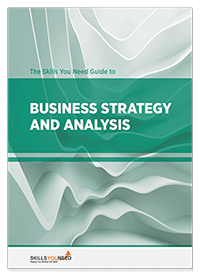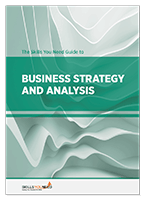SWOT Analysis
See also: Personal SWOT AnalysisA SWOT analysis - or looking at Strengths, Weaknesses, Opportunities and Threats - is a simple but useful structure for examining any situation or event. It can be used both on a personal level, and on a business level.
SWOT analysis is particularly helpful in a developmental context because it allows you to explore the positives and negatives of both you (or your organisation) and the external environment in a relatively safe and controlled way. It can therefore be used in career discussions and in strategy discussions in businesses, where all options can be put on the table and discussed.
How to do SWOT Analysis
As you might expect, SWOT analysis covers four areas: strengths, weaknesses, opportunities and threats. As a general principle:
Strengths and weaknesses relate to you or your organisation: they are internal factors; and
Opportunities and threats relate to the external environment: they are external factors.
SWOT analysis is often done in a ‘grid’ format, taking a piece of paper and dividing into four quarters, with one heading in each. This means that you can see easily which area might be a problem. You can, however, do it just as easily as a simple list.
Specific or General?
SWOT analysis can be used to look at your general situation, or a much more specific problem that you or your organisation are facing.
The things you identify in each area will be different depending on whether you are looking at the general or specific.
It is therefore important to make sure that you (and everyone involved) is clear about what you are discussing.
1. Strengths
Under ‘strengths’, you need to list things that are unique to you or your organisation, as these are things that give you an advantage. For the organisation, they may include:
Intellectual property rights, patents and copyrights;
A cheaper manufacturing process than others;
A source of cheaper or better raw materials;
A quality advantage that others cannot copy;
Relationships with customers built up over time.
You should ask yourself: “What can or do we do better than anyone else?”
It is worth answering this both from your own point of view and by considering what your customers, peers and suppliers might say. If you have good relationships with your customers and suppliers, you could even ask them directly.
2. Weaknesses
Weaknesses can be considered as the areas where you struggle. What don’t you do as well as your competitors? What factors lose you sales? For example, is your customer service poor, or are your prices higher than your competitors although you are offering a very similar product?
Again, it is worth considering both your own views and those of your customers (and potential or lost customers). Finding out what lost customers think may need some market research.
The key in this section is to be realistic. You need to face up to problem areas so that you can address them.
3. Opportunities
Identifying opportunities requires you to look outwards and also into the future a little. What is on the horizon that you may be able to take advantage of to gain a competitive advantage?
Possible opportunities include:
New technologies and/or changes in the market that you may be able to exploit faster than your competitors;
Global changes such as lifestyle changes, population movements, and political shifts that may affect your customers’ views and how they wish to buy or behave;
Changes in regulation or political opinions that you need to consider early; and
Local or national events that you could use as a selling opportunity or a way to raise your profile.
Opportunities may require you to change to take advantage of them (for example, you may need to recruit new staff, or develop new skills). As you identify opportunities, it is therefore also worth highlighting anything that you would need to do to exploit them fully.
TOP TIP! Use your strengths and weaknesses to identify opportunities
When you have identified all the obvious opportunities, it is a good idea to review your strengths and see if any of them open up new opportunities in anyone’s mind. You can also review your weaknesses, and ask yourself if you could take advantage of other opportunities if you could eliminate any weaknesses.
4. Threats
Threats include anything that could harm your business, or damage your position in the market. They therefore include:
Changes to government regulations that could make it harder to do business or eliminate an advantage you currently hold;
Changes in your competitors that could enable them to catch and/or overtake you;
Financial issues that might prevent you taking advantage of opportunities (for example, excess debt, or controlling shareholders);
Changes in the market or more widely that could threaten your position (for example, new technology that opens up new ways to do business).
Remember, threats are often the ‘flip side’ of opportunities.
A threat, identified early, could become an opportunity if you can overcome it faster than your competitors.
When to use SWOT analysis
You can use SWOT analysis in several ways, and with several purposes. For example:
It is a useful ice-breaker and starting exercise in any strategic planning, because it gets everyone thinking about the organisation along the same lines, and with a common understanding of the problems and advantages that they face.
It can be used to surface hidden issues and problems in a ‘safe’ way, because its structure requires discussion about problems and weaknesses.
It can be used to discuss one or more very specific problems and identify the way forward.
It is also useful in thinking generally about a change in strategy and ‘where shall we go next?’ questions.
You can also use it to think about your competitors, and analyse their position to show where you could take advantage.
It is, in other words, very flexible. This means that if you don’t feel that you are getting very much by operating at a particular level (for example, thinking about the general challenges that the organisation or group faces), you may want to stop and drill down in more detail in a particular area instead.
TOP TIP!
Getting the most out of SWOT analysis for strategic planning
SWOT analysis is at its best when participants are required to be as specific as possible. For example, they should be challenged to quantify likely gains from particular opportunities or strengths, and not just say ‘better value’.
If there is time, it is also helpful to get participants to think about which factors are most important, so that there is some agreement on priorities for action.
Remember to carry forward the findings from the SWOT analysis into later strategic planning.
A final thought
SWOT analysis has been around and used in business for about 50 years. Its simple structure is easy to apply, and very flexible, making it a useful tool in many situations.
Sometimes, the old ones really are the best!
Further Reading from Skills You Need
The Skills You Need Guide to Business Strategy and Analysis
Based on our popular management and analysis content the Skills You Need Guide to Business Strategy and Analysis is a straightforward and practical guide to business analysis.
This eBook is designed to give you the skills to help you understand your business, your market and your competitors.
It will help you understand why business analysis is important for strategy—and then enable you to use analytical tools effectively to position your business.


